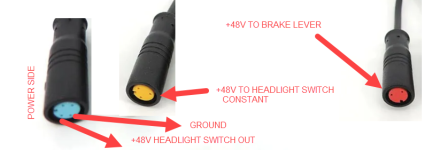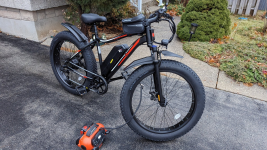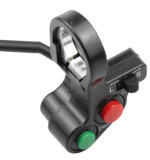romandesign
1 mW
Got myself a first ebike - an inexpensive 48V 26"x4" fat ebike with S830 display. It doesn't have a tail light. I want to add a working tail light with brake light and blinkers, as inexpensively as possible, and without voiding the warranty (means no cutting and splicing). But I'm puzzled by the wiring, need to figure it out so I don't short and burn anything... At the steering bar, my wiring harless looks like this. I understand this is called 1T4 wiring harness, correct? Only my harness has 2 yellows instead of one. The left yellow is wired to headlight and horn switch, which shorts one of the 2 pins with the common pin on the second yellow connector. 2 Reds are brakes, right Yellow is the throttle, and Green is the display.
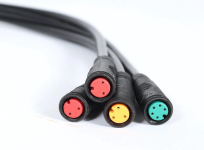
My plan is to buy Y-cables (splitters) to tap into +48V voltage, ground and brakes, cut one of their ends and wire this switch from Ali Express:
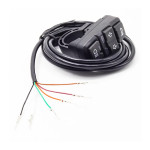
It has a really Chingrish pinout, someone has posted than red,yellow and brown need to be shorted, which makes sense if they are +48V:
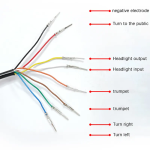
And this is the tail light with blinkers:
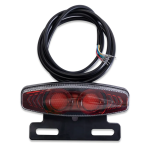
Both switch and tail light say "48V" in the description, so I hope it whould work.
- I can't find any pinouts for this! I don't even know where the ground is.
- How would I do the break lights? What voltage is there that brake levers short? Can't even measure without knowing what pin the ground is... Can I wire them directly? Or do I need 5V relays to connect +48V to the break light?
- I suppose the Green connector to display has +48V and ground that I can tap, and feed to tail light, blinkers and break, correct? Which pins though?
I'd appreciate any advice!

My plan is to buy Y-cables (splitters) to tap into +48V voltage, ground and brakes, cut one of their ends and wire this switch from Ali Express:

It has a really Chingrish pinout, someone has posted than red,yellow and brown need to be shorted, which makes sense if they are +48V:

And this is the tail light with blinkers:

Both switch and tail light say "48V" in the description, so I hope it whould work.
- I can't find any pinouts for this! I don't even know where the ground is.
- How would I do the break lights? What voltage is there that brake levers short? Can't even measure without knowing what pin the ground is... Can I wire them directly? Or do I need 5V relays to connect +48V to the break light?
- I suppose the Green connector to display has +48V and ground that I can tap, and feed to tail light, blinkers and break, correct? Which pins though?
I'd appreciate any advice!


